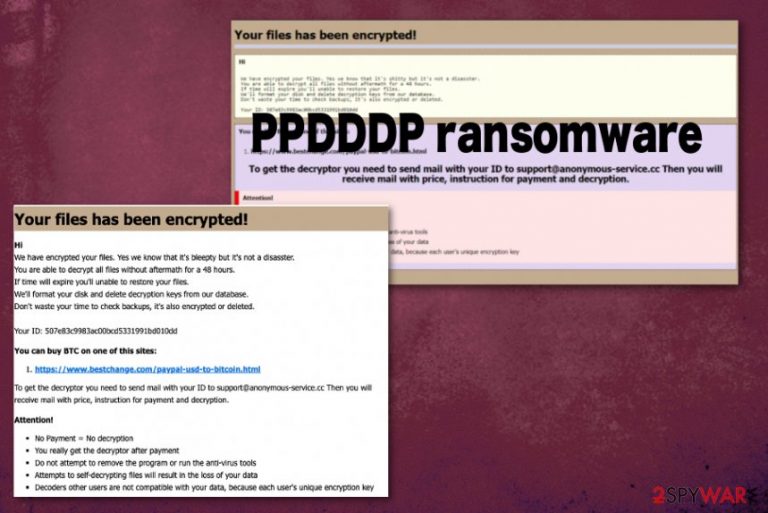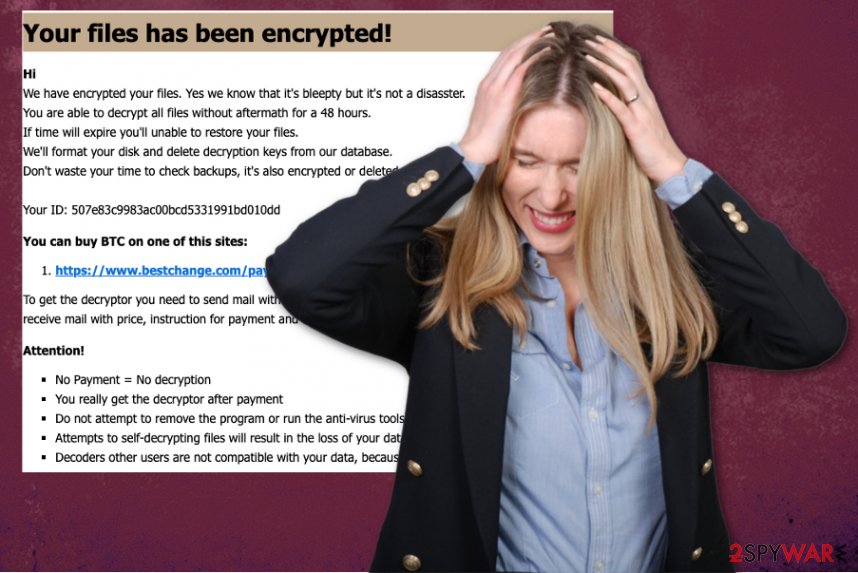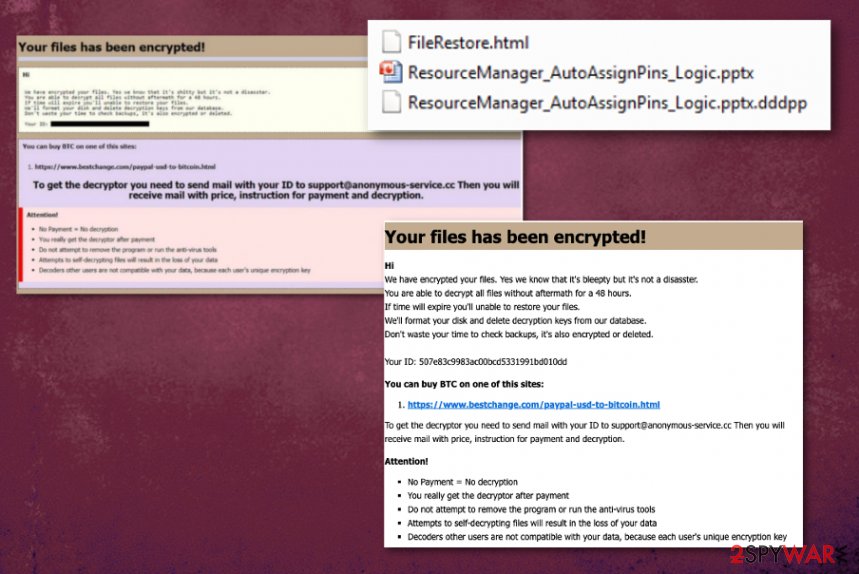PPDDDP ransomware (Free Guide) - Decryption Methods Included
PPDDDP virus Removal Guide
What is PPDDDP ransomware?
PPDDDP ransomware is the cryptovirus that encrypts files and damages selective data on the computer

However, malware experts reported[1] that the PPDDDP ransomware virus is still to be investigated because no samples have been submitted yet. The ransom note seems similar, but the contents of this Filerestore.html file are new. As typical for cybercriminals, they try to fake legitimacy and trust, so the message is quite polite and instructional. However, paying these people can lead you to more issues with the machine and even privacy or end up in permanent money and data loss. The price is determined when the victim contacts virus developers directly, so it can get up to hundreds or thousands of dollars in Bitcoin. Do Not write to them at any circumstances. Especially knowing that this threat has a few versions already. The most recent one is a threat that marks files using .dddpp extension.
| Name | PPDDDP ransomware |
|---|---|
| File marker | The pattern that virus uses to append files can differ, and sometimes it doesn't even include the original filename that was known for encryption. However, for the most part, .support@anonymous-service.cc.ppdddp is the extension that shows up on the file once image or document gets encoded |
| Ransom note | FilesRestore.html program window appears once the selected data gets encoded and informs victims about particular actions they can take after that. The message contains your victim's ID and contact information for virus developers, the address where you can get Bitcoins needed for the payment |
| Distribution | Malware is spread via spam email and breaking through unprotected RDP configurations.[2] Criminals also can rely on malicious or hacked sites to deliver this threat around the globe |
| Unique features | Malware is choosing which files to encrypt, not all of them get locked. In one folder, some files get encoded, some damaged, and some permanently corrupted. There is no particular pattern for the selectivity |
| Versions | .dddpp |
| Contact emails | crptcloud@protonmail.ch, support@anonymous-service.cc |
| Danger | This is the virus based on cryptocurrency extortion and blackmail, so you can end up losing money and data of you decide to pay. Also, ransomware can run additional processes in the background to affect or even damage the machine further |
| Elimination | PPDDDP ransomware removal is the process that should be taken seriously, so get an anti-malware program or a similar security tool an run a full system scan to find all malicious files and intruders |
| Repair | Remember that malware can damage the machine from the inside with additional files, programs, and other processes. To get rid of these risks and damage, rely on FortectIntego that can find and fix issues with the system and computers' performance |
Even though PPDDDP ransomware is a unique and new threat it is still a cryptovirus that focuses on encryption and ransom demanding, so profits can get made. It chooses various types of files and encodes them using the AES encryption algorithm and changing the original code of the file. The file marker with email and .ppdddp appendix then appears at the end of the filename.
Not all files get encrypted. In each folder, the PPDDDP ransomware virus selects some files for encryption and composes the name with the name of directory, account, file type, and the extension marking the virus name. Encoded files have a pseudo-XML with the original name of the data and different names at the end. The root folder shows the encrypted file, other items get blank icons with the same name remaining, and the rest gets ruined. Some of the data that gets corrupted becomes useless and the size of 0 Kb.
When malware is done with the encryption processes the further actions get listed on the ransom note that PPDDDP ransomware places on the desktop and opens on the screen directly. The program window lists the places where you can buy Bitcoin and email addresses that is the primary way to contact extortionists. There is no particular ransom amount listed on the initial ransom message because criminals decide the final payment when you contact them.
Thee ransom note file names FileRestore.html displays the following:
Your files has been encrypted!
Hi
We have encrypted your files. Yes we know that it's shitty but it's not a disasster .
You are able to decrypt all files without aftermath for a 48 hours.
If time will expire you'll unable to restore your files.
We'll format your disk and delete decryption keys from our database.
Don't waste your time to check backups, it's also encrypted or deleted.
Your ID: 507e83c9983ac00bcd5331991bd ***** [total 32 characters]
You can buy BTC on one of this sites:
https://www.bestchange.com/paypal-usd-to-bitcoin.html
To get the decryptor you need to send mail with your ID to support@anonymous-service.ccThen you will receive mail with price, instruction for payment and decryption.
Attention!
No Payment = No decryption
You really get the decryptor after payment
Do not attempt to remove the program or run the anti-virus tools
Attempts to self-decrypting files will result in the loss of your data
Decoders other users are not compatible with your data, because each user's unique encryption key
It may seem the only solution for such infection, but you need to remember that these people are criminals, and they want only your money. They don't care about your data, and it is exceptionally easy to send you malware via email without providing any decryption. So remove PPDDDP ransomware instead of writing any email for these people. 
No matter how trustworthy the test decryption option seems or how polite PPDDDP ransomware developers are, you need to ignore any blackmail messages, demands, and claims about the alleged decryption tool. This software may not even exist and is listed as the only option, so you will pay. Ransom amount can go up to thousands of dollars, so do not even consider paying.
PPDDDP ransomware is powerful and can easily inject other processes and files on the machine, so you cannot access security tools or data recovery options that easily. There are lots of programs and files that can get loaded on the system to keep victims from getting their files back. Shadow Volume Copies may get deleted, so there are not many other data recovery options.
We have listed a few decryption. File restoring solutions for you below the PPDDDP ransomware termination guide. However, the best option for that is anti-malware tools. Remember that cryptovirus drops additional files, runs secondary payloads and install applications, alters functions, registry entries. You cannot find all the associated intruders and files yourself. AV engines can do that for you.
As for the system files that get damaged by the .PPDDDP virus, you should rely on additional help from system repair tools or optimizers like FortectIntego, so damage is fixed, features, and functions repaired without any interference with other processes. These system scans save time for you and ensure that data recovery is safe to perform. These methods are the ones that experts[3] recommend going for. 
Payload droppers can b found on spam emails and in craking tools
Malicious infections like this happen silently, and without any symptoms, so you cannot notice the infection happening, only the aftermath – encryption and other changes. The malicious script gets triggered when the payload is dropped on the machine. This is the process that happens via social media, file-sharing services or even hacked websites.
Email attachments in the format of Microsft documents or even direct links placed in the notification can trigger the drop of ransomware or a virus that infiltrates the cryptovirus on your computer. Hackers can also find vulnerabilities in RDP configurations and programs and exploit those flaws for their advantage.
Stay away from torrent services, avoid cracking software and game cheats. Also, always be cautious when receiving emails out of nowhere. Notifications that are not expected can contain scripts that get easily triggered when opened or attachments get downloaded. Keep the system virus-free by being suspicious of anything that comes out of nowhere.
Get rid of the shady PPDDDP ransomware virus completely
The new versions of PPDDDP ransomware virus can become more persistent than this initial variant, so take that into consideration and make sure to react as soon as you possibly can. Remember that ransomware can be running in the background before it encodes your data and that background processes triggered by the malware are dangerous as well.
Even though we cannot guarantee that your damaged data or the ones that got encrypted can be fully recovered, you need to at least try to salvage those documents, images, and archives. The first step, however, should be the PPDDDP ransomware removal procedure using anti-malware tools like SpyHunter 5Combo Cleaner, Malwarebytes, or other AV engines.
When you are sure that you have the best tools to remove PPDDDP ransomware, go ahead and scan the machine fully, delete all indicated programs or files and double-check before doing anything else. FortectIntego can help you with that because of such application checks for damaged system files and functions and repairs them when it is possible. Then you can go for data recovery.
Getting rid of PPDDDP virus. Follow these steps
Manual removal using Safe Mode
Make the machine virus-free by running the system in Safe Mode with Networking and removing PPDDDP ransomware using AV tools
Important! →
Manual removal guide might be too complicated for regular computer users. It requires advanced IT knowledge to be performed correctly (if vital system files are removed or damaged, it might result in full Windows compromise), and it also might take hours to complete. Therefore, we highly advise using the automatic method provided above instead.
Step 1. Access Safe Mode with Networking
Manual malware removal should be best performed in the Safe Mode environment.
Windows 7 / Vista / XP
- Click Start > Shutdown > Restart > OK.
- When your computer becomes active, start pressing F8 button (if that does not work, try F2, F12, Del, etc. – it all depends on your motherboard model) multiple times until you see the Advanced Boot Options window.
- Select Safe Mode with Networking from the list.

Windows 10 / Windows 8
- Right-click on Start button and select Settings.

- Scroll down to pick Update & Security.

- On the left side of the window, pick Recovery.
- Now scroll down to find Advanced Startup section.
- Click Restart now.

- Select Troubleshoot.

- Go to Advanced options.

- Select Startup Settings.

- Press Restart.
- Now press 5 or click 5) Enable Safe Mode with Networking.

Step 2. Shut down suspicious processes
Windows Task Manager is a useful tool that shows all the processes running in the background. If malware is running a process, you need to shut it down:
- Press Ctrl + Shift + Esc on your keyboard to open Windows Task Manager.
- Click on More details.

- Scroll down to Background processes section, and look for anything suspicious.
- Right-click and select Open file location.

- Go back to the process, right-click and pick End Task.

- Delete the contents of the malicious folder.
Step 3. Check program Startup
- Press Ctrl + Shift + Esc on your keyboard to open Windows Task Manager.
- Go to Startup tab.
- Right-click on the suspicious program and pick Disable.

Step 4. Delete virus files
Malware-related files can be found in various places within your computer. Here are instructions that could help you find them:
- Type in Disk Cleanup in Windows search and press Enter.

- Select the drive you want to clean (C: is your main drive by default and is likely to be the one that has malicious files in).
- Scroll through the Files to delete list and select the following:
Temporary Internet Files
Downloads
Recycle Bin
Temporary files - Pick Clean up system files.

- You can also look for other malicious files hidden in the following folders (type these entries in Windows Search and press Enter):
%AppData%
%LocalAppData%
%ProgramData%
%WinDir%
After you are finished, reboot the PC in normal mode.
Remove PPDDDP using System Restore
System Restore can help your device by recovering the machine in a previous state when the PPDDDP ransomware virus was not active
-
Step 1: Reboot your computer to Safe Mode with Command Prompt
Windows 7 / Vista / XP- Click Start → Shutdown → Restart → OK.
- When your computer becomes active, start pressing F8 multiple times until you see the Advanced Boot Options window.
-
Select Command Prompt from the list

Windows 10 / Windows 8- Press the Power button at the Windows login screen. Now press and hold Shift, which is on your keyboard, and click Restart..
- Now select Troubleshoot → Advanced options → Startup Settings and finally press Restart.
-
Once your computer becomes active, select Enable Safe Mode with Command Prompt in Startup Settings window.

-
Step 2: Restore your system files and settings
-
Once the Command Prompt window shows up, enter cd restore and click Enter.

-
Now type rstrui.exe and press Enter again..

-
When a new window shows up, click Next and select your restore point that is prior the infiltration of PPDDDP. After doing that, click Next.


-
Now click Yes to start system restore.

-
Once the Command Prompt window shows up, enter cd restore and click Enter.
Bonus: Recover your data
Guide which is presented above is supposed to help you remove PPDDDP from your computer. To recover your encrypted files, we recommend using a detailed guide prepared by 2-spyware.com security experts.If your files are encrypted by PPDDDP, you can use several methods to restore them:
Data Recovery Pro is the program capable of restoring your files after ransomware attack
Get the program and try to recover encrypted files or the data that got deleted accidentally
- Download Data Recovery Pro;
- Follow the steps of Data Recovery Setup and install the program on your computer;
- Launch it and scan your computer for files encrypted by PPDDDP ransomware;
- Restore them.
Recover PPDDDP ransomware encoded data with Windows Previous Versions
When System Restore gets enabled it allows the opportunity to restore affected data using Windows Previous Versions
- Find an encrypted file you need to restore and right-click on it;
- Select “Properties” and go to “Previous versions” tab;
- Here, check each of available copies of the file in “Folder versions”. You should select the version you want to recover and click “Restore”.
ShadowExplorer – a method for recovering files after PPDDDP ransomware virus invasion
When Shadow Volume Copies are left untouched, you can easily restore files using them
- Download Shadow Explorer (http://shadowexplorer.com/);
- Follow a Shadow Explorer Setup Wizard and install this application on your computer;
- Launch the program and go through the drop down menu on the top left corner to select the disk of your encrypted data. Check what folders are there;
- Right-click on the folder you want to restore and select “Export”. You can also select where you want it to be stored.
PPDDDP ransomware cannot be decrypted
Finally, you should always think about the protection of crypto-ransomwares. In order to protect your computer from PPDDDP and other ransomwares, use a reputable anti-spyware, such as FortectIntego, SpyHunter 5Combo Cleaner or Malwarebytes
How to prevent from getting ransomware
Access your website securely from any location
When you work on the domain, site, blog, or different project that requires constant management, content creation, or coding, you may need to connect to the server and content management service more often. The best solution for creating a tighter network could be a dedicated/fixed IP address.
If you make your IP address static and set to your device, you can connect to the CMS from any location and do not create any additional issues for the server or network manager that needs to monitor connections and activities. VPN software providers like Private Internet Access can help you with such settings and offer the option to control the online reputation and manage projects easily from any part of the world.
Recover files after data-affecting malware attacks
While much of the data can be accidentally deleted due to various reasons, malware is one of the main culprits that can cause loss of pictures, documents, videos, and other important files. More serious malware infections lead to significant data loss when your documents, system files, and images get encrypted. In particular, ransomware is is a type of malware that focuses on such functions, so your files become useless without an ability to access them.
Even though there is little to no possibility to recover after file-locking threats, some applications have features for data recovery in the system. In some cases, Data Recovery Pro can also help to recover at least some portion of your data after data-locking virus infection or general cyber infection.
- ^ Amigo-A. New #PPDDDP #Ransomware. Twitter. Social media platform.
- ^ Mark Stockley. Ransomware-spreading hackers sneak in through RDP. Nakedsecurity. Sophos blog.
- ^ Bedynet. Bedynet. Spyware related news.







